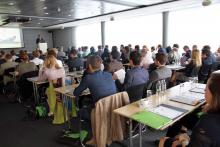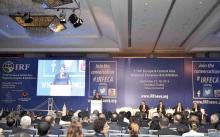A new transport maintenance workshop is planned for Istanbul, Turkey in May 2018. The second SENsing SKIN (SENSKIN) workshop for Monitoring-Based Maintenance of the Transport Infrastructure will be held from 24th - 25th May 2018. The First SENSKIN Workshop was held on 8th November 2017 in Brussels.
The SENSKIN programme is a 48-month Horizon 2020 project implemented by 13 partners from seven countries. This aims to develop a skin-like sensor that offers spatial sensing and can monitor strains of various intensities on transport bridges or other critical infrastructures. An Emerging Delay Tolerant Network technology is used, so that the measurements of the sensors can be transmitted to the highways’ control centres even under difficult conditions, such as in the case of an earthquake, where communication networks may become inoperable. The sensor measurements provide input for structural assessment, while a dedicated Module evaluates the rehabilitation options. The whole system will be integrated to provide decision support on the timing and type of rehabilitation based on the identified damage, structural condition and available rehabilitation options. The system will be field evaluated in the Bosporus 1 bridge in Istanbul with an average daily traffic of 200,000 vehicles and a bridge on the Greek Egnatia Motorway that connects Europe to Asia. A series of workshops are taking place to get key stakeholders informed and actively involved.
In the first workshop around 40 participants provided valuable input to the work of the project. The aim of this first workshop was to analyse the requirements and methodology of the SENSKIN monitoring system. To facilitate and enhance knowledge exchange between practitioners in the field of Structural Health Monitoring (
The first session was titled Setting the Scene and following a welcome by Adewole Adesiyun from
The second session was titled Bridge Monitoring Systems - Users' Needs and Challenges and was moderated by Konstantinos Loupos. This session started with a presentation by Panagiotis Panetsos of Egnatia Motorway, Greece on the bridge structures of Egnatia Motorway.
The second presentation by Şengül Kaya from
The last presentation, given by Piotr Olaszak from IBDiM Poland, was entitled "Bridge Deflection Monitoring Systems - The application of inertial sensors".
For the third session ‘The SENSKIN Monitoring System’, the Consortium members described the progress made so far. This started with an overview of the Prototype of Sensing Elements by Dmitry Rychkov of the University of Potsdam, Germany. The second presentation, “SENSKIN Integrated Monitoring System”, given by Konstantinos Loupos, described the modules/sub-systems that constitute the monitoring system. Peter Jones' (TRL UK) presentation, “Laboratory Tests on Prototypes”, focused on the various laboratory tests conducted on the sensors. The fourth presentation, “The Structural Assessment Modules”, given by Sanna Corrado of TECNIC SA in Italy, explained the objectives of the structural modulus. The last presentation given by Panagiotis Panetsos explained the work to field evaluate and benchmark the system and integrated package on two actual and in-service bridges - the Bosporus Bridge in Istanbul and the Egnatia G4 Ravine Bridge in Greece.
For the fourth session ‘Monitoring Systems of Civil Infrastructure’, a number of other monitoring systems were presented. The first, “Acoustic Emission for Structural Health Monitoring”, was presented by Jon Watson and Nassos Anastasopoulos of
The third system, Aerial Robotic System for In-Depth Bridge Inspection by Contact (www.aerobi.eu), was presented by Adewole Adesiyun from FEHRL.
The last presentation by Lorcan Connolly of ROD gave an overview, of the SAFE 10T project (www.safe10tproject.eu), which is developing a Safety Framework to ensure high safety performance while allowing longer life-cycles for critical infrastructure.
And the fifth session was a Panel Discussion. The Project Coordinator thanked the participants for their presence and closed the workshop.
Transport maintenance event for Istanbul, Turkey
A new transport maintenance workshop is planned for Istanbul, Turkey in May 2018. The second SENsing SKIN (SENSKIN) workshop for Monitoring-Based Maintenance of the Transport Infrastructure will be held from 24th - 25th May 2018. The First SENSKIN Workshop was held on 8th November 2017 in Brussels.






